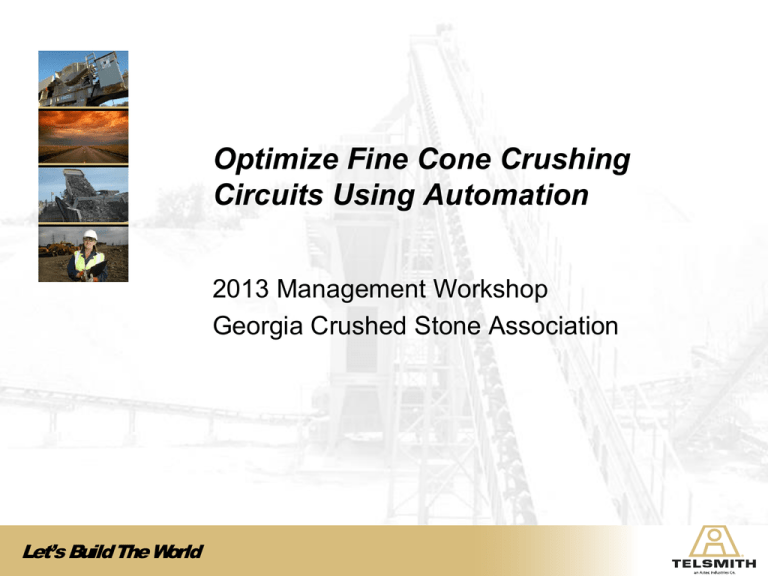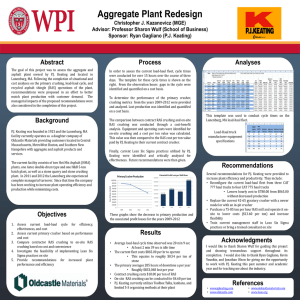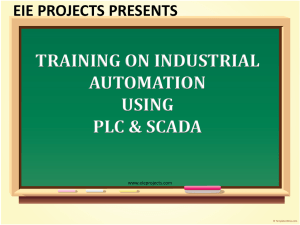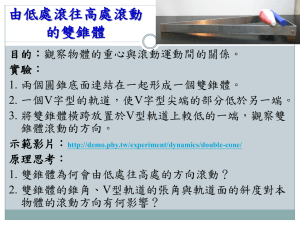Using Automation in Fine Cone Crushing Circuits
advertisement

Optimize Fine Cone Crushing Circuits Using Automation 2013 Management Workshop Georgia Crushed Stone Association Let’s BuildThe World Presentation Summary In today’s market the demand for fine aggregates has risen. Many crushing plants have added or modified crushing circuits to increase the production of minus 3/8” rock typically used in asphalt. Automation packages ensure you maximize cone productivity while protecting the machine from overload. Let’s BuildThe World The Challenge • Receive a fine feed gradation – Minus 1-1/2” or 2” – Allow for varied feed gradations depending on inventory balance • Produce fine products – ½” minus, 3/8” minus, MFG sand • Maximize production while protecting the crusher Let’s BuildThe World Cone Feed Video Let’s BuildThe World Cone Discharge Video Let’s BuildThe World Things We Need to Understand • What happens in the crushing chamber • Mechanical limits of fine crushing • What data can be collected from crusher systems • What a good cone applications is • How does fine crushing affect performance Let’s BuildThe World Ideal - Evenly Graded Feed Best Performance – reduction & TPH – 90 to 100 percent passing the closed side feed opening. – 40 to 60 percent passing the mid point of the crushing chamber. – 0 to 10 percent passing the crusher setting. Let’s BuildThe World Benefit of a well graded feed. Allows for effective Inter-Particle Crushing Need room for expansion (voids) Let’s BuildThe World What We Have in Fine Crushing Fine material fills the voids between the coarser stone. The crushing stroke compresses the material, eliminating any voids and packing material into a solid mass. (most sensitive at smaller settings) Let’s BuildThe World Crusher Overload in Fine Crushing “Packing / Float” Let’s BuildThe World Liners • Typically a “fine” chamber is used • Temporary situation – Make due with what’s in the crusher – Live with issues • CSS • Short liner life • Output gradation Let’s BuildThe World Match Profile to Feed Let’s BuildThe World Two Areas for Automation • Cone Automation – Collect sensor information – Make decision to protect the machine and continue operation – Assume some human decisions • Plant Automation – Integrate multiple pieces of equipment to act in unison and optimize production – Reduce need for human interaction in the plant operation Let’s BuildThe World Benefits of Cone Crusher Automation Change crusher setting remotely Automatic liner calibration Protects from overload conditions Tracks liner wear Logs and trends data Versatile Minimizes installation costs Highly effective troubleshooting tool Let’s BuildThe World Typical Components Operator Interface Terminal (OIT) The control panel enclosure is located inside the operator control room. ALL trending data is stored on Compact Flash memory card Optional USB Mouse Optional USB Printer Select list of printers Ethernet Network Crusher Panel Ethernet Communication Hub is located inside PLC enclosure. Optional Modem PLC (Programmable Logic Controller) This is where the base program resides and all the calculations and decision are made. Hardware connections are made to motor starters that supply or receive instructions from the PLC PLC Panel The PLC and the communication devices are supplied in an enclosure for mounting inside the Motor Control Room. Let’s BuildThe World DeviceNet Network Located at the crusher lube tank, this unit centralizes the communication from the many crusher sensors and routes them to/from the PLC which is located in the motor control room. Crusher Protection • • • • Oil temp & flow Hydraulic temp & pressure Alarms and interlocks Auto protect (open setting) – Amp draw – Bowl float • Maintenance Let’s BuildThe World Troubleshooting • Alarm history • Trending reports • Communicate with factory Let’s BuildThe World Liner Life & Calibration Let’s BuildThe World Trending TRAC10 Let’s BuildThe World ® Alarm History TRAC10 Let’s BuildThe World ® Today’s Cones in Fine Crushing Video Let’s BuildThe World Today’s Cones - Settings • Variables that affect settings – Feed gradation – Moisture in feed – Screening efficiency – Specification requirements of finished product – Depth of choke feed above head • Goal is to utilize horsepower to the fullest extent while protecting the crusher Let’s BuildThe World Cone Automation = Optimum setting & Optimum Production Let’s BuildThe World What is the “Optimum” CSS Worth? • NO automation – Run cone at .70” CSS – This is “Safe” setting – Never an issue – Don’t need to watch too close – Makes 155 TPH 3/8” x 0 • Automated cone – Runs 90% of the time at .60” CSS (10% at .70”) – This is “Optimum” setting – Makes 165 TPH 3/8 x 0 when at .60” CSS – 18,000 extra tons per year ($$$,$$$) Let’s BuildThe World CSS Optimization • Manual set back – Indicator notice or light • Auto return on timer – Periodic return to set point Let’s BuildThe World Try Different Levels in Cone • What gives you the best output gradation – Lower depth of material & tighter setting – More depth and larger setting • Feed gradation changes – As gradation changes voids in chamber change Let’s BuildThe World Vary the Feed Gradation • Coarser Feed – More voids – Tighter CSS – Lower AMP draw Let’s BuildThe World • Finer Feed – Less room for expansion = packing – Higher AMP draw – May generate more sand Plant Automation • Level sensor in cone • Level sensor in bin • Communicates with surge feeders •Cone overflow chutes with presence detector •Belt scales •Zero speed switches Let’s BuildThe World Plant Automation – PID Controllers • Proportional-integral-derivative Controllers – PID controller calculates an "error" value as the difference between a measured process variable and a desired set point. – The controller attempts to minimize the error by adjusting the process control inputs. – PID controller can be used to control any process which has • a measurable output, • a known ideal value for that output and • an input to the process that will affect the relevant measureable output – Thinks for us so we don’t have to stare at cameras and spin dials all day Let’s BuildThe World Plant Automation – PID Controllers • Controllers communicate with – Feeder VFD’s – Level sensors – Belt scales – Crusher AMP outputs • Logic is developed specific to your crushing circuit Let’s BuildThe World Plant Automation Sensing & Feedback Devices • • • • • • Laser Radar Ultrasonic Tilt Switches Presence detector Zero speed switch Let’s BuildThe World Plant Automation Sensing & Feedback Devices • Variables that determine what level sensor is used – – – – – Distance from target Range of measurement Lump size of particles Flow of material into bin or chamber Dust • Radar common in bins • Laser common in crusher chamber Let’s BuildThe World Laser level sensor in cone chamber Track Plants Laser Let’s BuildThe World Ultrasonic Tilt Switch – overflow protection Radar Sensor used for bin level. Let’s BuildThe World Don’t Forget Your Screening • Account for heavier recirculation loads – 35-40% vs 15-20% – Consider one size larger than normal – May use two decks to cut topsize • Split loads, reduce bed depth – Check speed & stroke on screen • Weigh pros and cons of wet or dry screening • Specialty media Let’s BuildThe World Process Flow Software doesn’t Tell the Whole Story • Software takes the incoming TPH and applies it to the manufacturers published output gradation • Using software you can feed sand to a cone and make 89’s (may get a warning) • Experience is a big part of the equation Let’s BuildThe World Process Flow Software doesn’t Tell the Whole Story in Fine Crushing • The fine cone crusher: – will find the setting it wants to run at not the software – setting will likely be greater than the desired P-100 (100% passing) – will likely reach the published TPH at the operating CSS – output gradation will not match the published output gradation at the operating CSS Let’s BuildThe World Estimating Net Finish Product In a Fine Crush Application • (A) Determine where crusher runs at based on auto-protect control (consult manufacturer) • (B) Determine average opening of screen cloth determining top size of product • Determine published capacity TPH midpoint of crusher at the CSS • Reduce published TPH midpoint 8% +/- per 1/16” differential between (A) & (B) Let’s BuildThe World Estimating Net Finish Product Example • (A) Crusher runs at .625” (per manufacturer) • (B) Product is cut on .375” wire cloth • Published midpoint capacity at 5/8” CSS is 257 TPH (225-290 range) • Differential between A & B is .250” or 4 / 16 • 4 x 8% = 32% is the differential between gross and net finish product • 257 TPH – 32% = 175 TPH net finished product (3/8” x 0) Let’s BuildThe World Create & Understand Your Constant • Benchmark existing equipment – Individual machine performance • Optimize existing circuit – Change one thing at a time & re-measure – Test circuit / test theory • Study material specifications – Talk to your customers – Gradation specifications – Cubicity requirements • Automate the areas that require the highest level of human process monitoring Let’s BuildThe World QUESTIONS? Let’s BuildThe World






